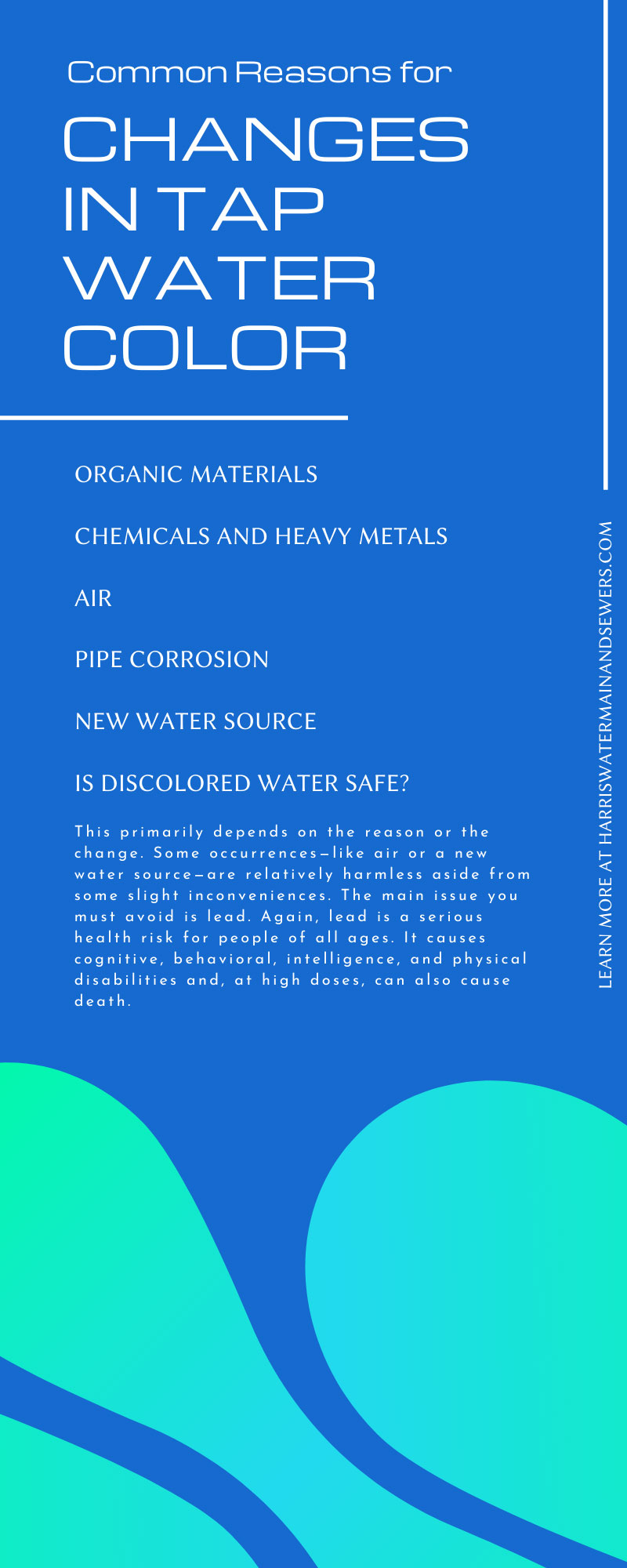There’s nothing inherently wrong with drinking water from the tap. However, sometimes unforeseen circumstances can impact the quality of your drinking water—sometimes to the point where it’s unsafe for consumption. Keep in mind these common reasons for changes in tap water color to know what to avoid.
Organic Materials
One of the most present reasons why your tap water changes color is simply due to the presence of organic materials. As dirt and other sediments settle in the water supply, it causes tap water to turn murky brown or yellow and may cause an odor. Dirt and natural debris only affect the water supply if there is a water main break, high-service demand, or firefighting. In each situation, the pipes speed up the water supply causing faster flow and more sediment in your potable water. While water with dirt in it is unpleasant to look at, it’s relatively harmless. Still, it may mean time to hire a replacement or water main repair if you prefer clear, odorless water.
Chemicals and Heavy Metals
Another common occurrence is the presence of chemicals and heavy metals. Similarly, this is due to water main breaks and corroding pipes. Be cautious of these contaminants. Chemicals and heavy metals pose serious health risks you must avoid. Some common chemicals and heavy metals that leach into the water supply include aluminum, ammonia, arsenic, copper, chlorine, mercury, nitrates, lead, and manganese. While some of these are relatively harmless, others—mercury, for instance—cause serious health issues which can prove fatal in large doses. It’s worth calling a professional water and sewer service to inspect the issue and reduce future occurrences.
Although you can always stock up on bottled water if your tap water has traces of these elements, you can also purchase a home filtration system to ensure your taps produce clear, palatable water.
Air
Water doesn’t oxidize, but air can change its initial appearance. If air is trapped in the water, it’ll look white or cloudy. This is due to issues in your plumbing system. Trapped air isn’t something to neglect. Air causes pipes to rust and corrode which leads to sediments in the water. Also, it lowers water pressure, inhibits water flow through the pipes, and may cause backflow. Additionally, if you hear banging or vibrations in your pipes, that means you have trapped air. Air gets trapped in water lines due to poor water system maintenance. Call a professional to address these issues. A residential plumbing service will fix your pipes to ensure equal air distribution throughout them and improve water flow to your fixtures.
Pipe Corrosion
As previously mentioned, pip corrosion is one of the most common reasons for changes in tap water color. Typically, residential, commercial, and industrial buildings use iron and manganese pipes, both of which produce orange or brown tap water along with unwanted contaminants. Even HDPE plastic pipes or rubber pipes can corrode over time leading to back contaminants and discolored water. The last thing you want is to ingest microplastics from your drinking water—this can cause serious health effects. Most importantly, if you live in an older building, watch out for lead pipes. As lead pipes corrode, the lead leaks into the tap water. Lead poisoning is a serious health concern that raises the risk of cognitive and physical issues in anyone who contracts it. Lead poisoning is also fatal in larger concentrations. If you suspect corrosion in your pipes, have a professional plumber or repairman service the area as soon as possible rather.
New Water Source
Your tap water may appear differently simply due to a change in the water source. Whether you’ve witched from well water to a river or reservoir, or vice versa, the water color may appear different from what you’re used to. A switch in water source affects the qualities and flow. In turn, this affects the taste, look, odor, and quality of your tap water. Lake water, well water, and other water sources contain different wavelengths that create different colors on the initial appearance. Well water is especially troublesome as this can cause calcium buildup, hard water, or soft water, which affects hair, skin, and basic utilities such as dishwashing or laundry. Aside from discoloration in your tap water, the minerals in well water create dryness, color fading, and discoloration in your clothes and dishes. Mitigate this problem through a plumber or water main treatment to protect your skin, dishes, and clothes.
Is Discolored Water Safe?
Given these many reasons for tap water discoloration, you’re probably still wondering: is it safe to drink? This primarily depends on the reason or the change. Some occurrences—like air or a new water source—are relatively harmless aside from some slight inconveniences. While organic materials, low water pressure, and hard water are concerning, they aren’t fatal or as serious as chemical or heavy metal infiltration. The main issue you must avoid is lead. Again, lead is a serious health risk for people of all ages. It causes cognitive, behavioral, intelligence, and physical disabilities and, at high doses, can also cause death. Instead of waiting for these risks to arise, call a plumber or water treatment and sewer repair team to fix the problems as soon as possible. You don’t want to risk the health and safety of yourself or others because of water treatment negligence.
If you live in New York City and notice discoloration in your tap water, call Harris Water Main and Sewer for your water main pipe installation. We service all five boroughs of NYC for all sub-surface installation and repairs for residential and commercial properties. We’re fully insured and licensed to bring the right knowledge, skill, and labor to every job site. With over 100 years of experience, we know what to do for every water main procedure to provide the best care and service available. Don’t wait. Call now to speak to our team and learn more about Harris Water Main and Sewer for your pipe and sewer issues.






















